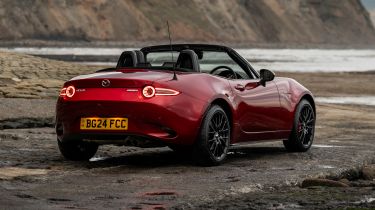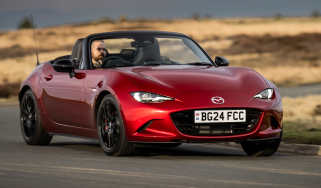Mazda MX-5 review - MPG, running costs & CO2
“Fuel-saving engine technology ensures the new Mazda MX-5 can put a smile on your face without breaking the bank”
Mazda placed a huge emphasis on low weight and low CO2 emissions when developing the Mazda MX-5, so it should be one of the cheapest sports cars to own. Over the years, the MX-5 has always been affordable to run, with good fuel economy as well as cheap parts and maintenance. Long-time fans will be pleased to know that the latest version continues the tradition.
Mazda MX-5 MPG & CO2
Out of the two engines, the 1.5-litre and 2.0-litre petrol engines, the smaller one is naturally more economical. The 1.5-litre engine can return up to 45.6mpg with emissions of 140g/km, while the larger 2.0-litre returns 41.5mpg with emissions of 153g/km. Every MX-5 costs the standard rate in annual road tax. These figures are pretty impressive and are thanks in no small part to the MX-5's lightweight construction. The extra 45kg of the RF’s folding metal hard-top roof doesn’t affect the car’s claimed fuel consumption and emissions figures.
Both engines use Mazda's SKYACTIV technology, which we tend to think does better at matching officially published fuel economy figures than the small turbo engines used by the likes of Fiat and Ford. Mazda’s ‘i-ELOOP’ fuel-saving technology was introduced to all models in the MX-5 range early on in 2020. This is made up of a new start-stop function as well as an energy recovery system to improve efficiency. The latter harvests energy under braking to help power the car's electrical systems, taking some of the strain off the engine to improve its efficiency.
Insurance group
Insurance won’t be cheap for any version of the latest MX-5. The entry-level model, with the 1.5-litre engine finds itself in insurance group 27 out of 50, while a 2.0-litre engine puts it into group 33. Believe it or not, the 2.0-litre turbocharged BMW 220i with around the same power sits in group 33, while the 230i with even more power sits in group 33. The M2 is much more expensive to insure in group 42, while the Porsche Boxster starts from group 44 rising to group 49 out of 50, though these are significantly more expensive and powerful.
Warranty
All new Mazdas are currently covered by a three-year/60,000-mile manufacturer’s warranty, a three-year surface-rust warranty for the paintwork and a 12-year guarantee against bodywork corrosion.
Servicing
Mazda offers fixed-price servicing packages, which can be paid for upfront in a lump sum or spread out over regular monthly instalments, so budgeting for maintenance should be relatively straightforward. Regular maintenance for the MX-5 shouldn’t cost significantly more than a family hatchback – however, regular enthusiastic driving is likely to increase tyre and brake wear, so it’s good that Mazda has stuck with sensible-sized wheels and brakes to keep costs relatively low.















